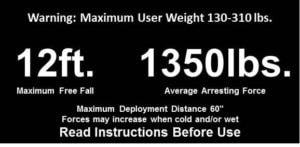|
By Bryan McClure We currently live in a world with ever-changing challenges as it relates to fall protection. It used to be as simple as telling workers to “stay tied off 100% of the time.” Or “make sure your anchor point can support your pickup truck (5000 lbs.)!” At the time, it was a victory just to get workers to tie off. But since the early 1990s, there have been great strides in fall protection planning, training and development. Product innovation has also helped to protect ironworkers from falls in ways we never expected 25 years ago. These innovations have led to a multitude of different products and manufacturers, all with different acceptable uses and component compatibilities. As a result, equipment is often used incorrectly or in the wrong situations. These are three of the most common mistakes I frequently see on steel erection sites.  1. Use of a D-Ring Extender with a Leading Edge Retractable On January 14, 2019, 3M issued a product advisory on the use of D-ring Extenders (also known as Pig Tails) with their leading edge self-retracting life lines. The problem that 3M discovered was that the D Ring extender would extend the external shock absorber further from the body during a fall which could lead to the shock pack coming in contact with the leading edge. When the shock pack contacted an unprotected sharp edge, it could sever. Hooking an SRL to your dorsal D Ring without an extender is very difficult to do by yourself. Needless to say, when I deliver this news to ironworkers it almost always is met with exasperation. Instead, the best way to connect the SRL to your D ring is to have a buddy help you. Not every leading edge SRL has an external shock absorber, and some are compatible with a D Ring extender. The only way to know for certain is to read the user manual.  2. Use of Hinged Anchors in the Weak Axis Fall arrest during decking operations is never easy. Rarely do deckers have the ability to anchor to an overhead structure. Consequently, they must tie off at foot level. The most user-friendly way to do this is to install a plate anchor to a fully attached sheet of decking with some self-tapping screws. Hinged anchors are very popular for this because they are inexpensive and light weight. Most hinged anchor manufacturers require that the end user attach their lanyard to the anchor so that the fall occurs in the long axis. Often, I see the anchor being tied off in the short axis. This configuration is too narrow, making it weak, which could result in failure if a fall were to occur. Not every plate anchor has this requirement. The only way to know for certain that you are using it correctly is to read the user manual. 3. Use of 6 ft. Free Fall Rated Lanyards for Foot Level Tie Off Probably the most popular fall arrest systems for ironworkers are beam anchors (also known as beamers) or cable anchors (cheater cables). Most ironworkers worth their weight in salt will walk the top flange of a beam. The problem with this when using a beamer or cheater cable is that you are exposing yourself to more than a 6 ft. free fall if you are tying off below your D ring. In fact, whenever you are tied off below your D ring, you are going to free fall more than 6 ft. with a six-foot-long static length lanyard, because you are increasing the free fall distance beyond 6 ft. In this scenario, it is better to be outfitted with a 12 ft. free fall rated lanyard. The only way to tell what your lanyard is rated for is to look at the tag attached to it. Most 6 ft. free fall rated lanyards are marked with black letters on a white background, while 12 ft. free fall rated lanyards usually have white letters on a black background. The only way to know for certain that you are using the correct lanyard is to read the user manual and or the tags on the lanyard. Referring to user’s manuals for all fall protection equipment is essential. If you do not have the user
manual, most manufacturers make manuals available for download from their website. No one likes to read instructions but it really is a must when it comes to the equipment, we are depending on to send our employees home safe to their families every day. Comments are closed.
|





 RSS Feed
RSS Feed
